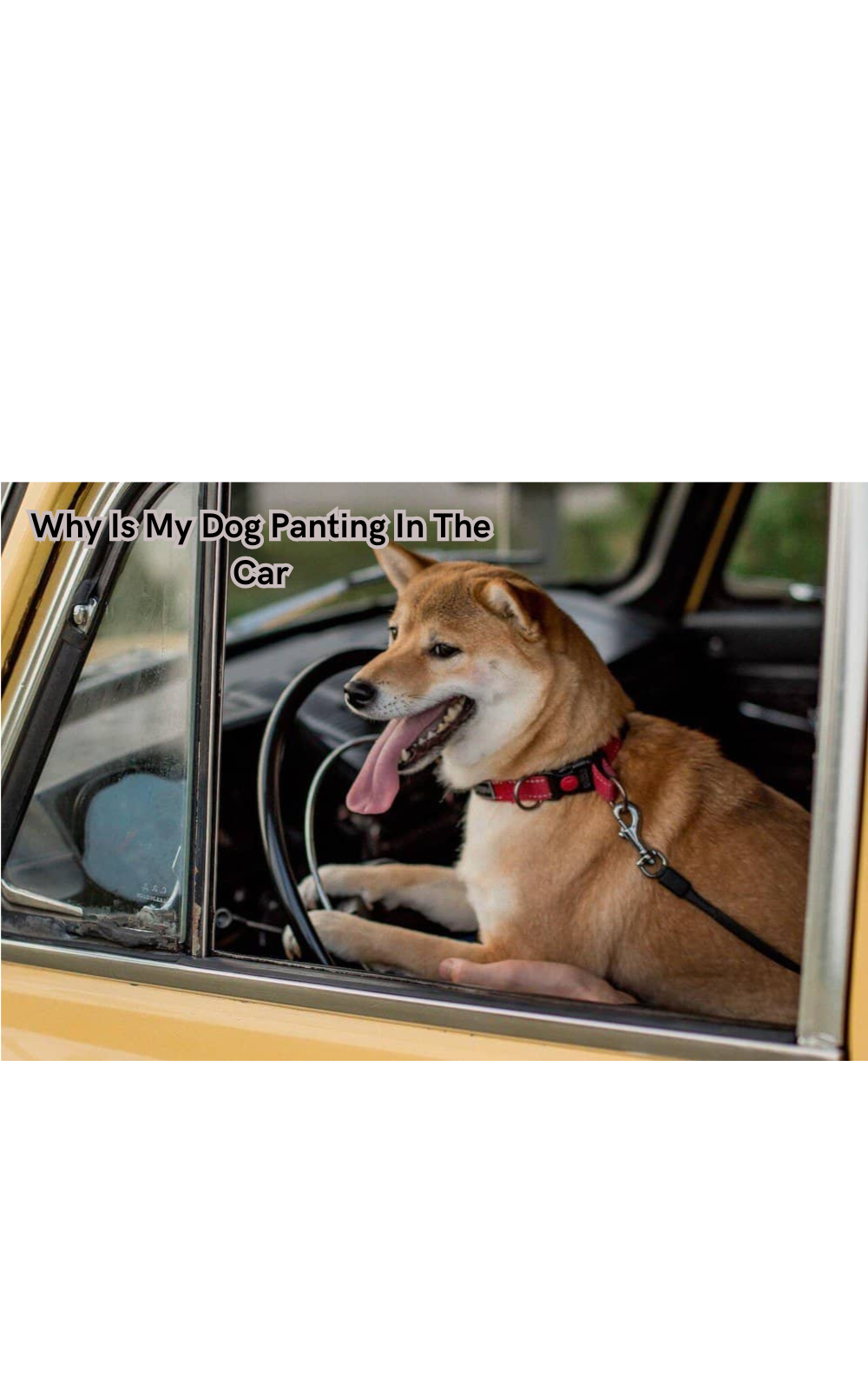Why Is My Dog Panting In The Car
Understanding the reasons behind your dog's panting can help address their needs and ensure a safer and more comfortable travel experience for your canine companion.

If your dog is panting excessively in the car, several factors could be at play, leading to this behavior. Panting in dogs serves as a mechanism to regulate body temperature, indicating that your furry friend may be feeling hot or stressed.
Car rides can induce anxiety or excitement in dogs, leading to increased panting as a response to the unfamiliar environment or motion sickness. Additionally, inadequate ventilation or uncomfortable seating arrangements within the car may contribute to your dog's discomfort and panting.
Understanding the reasons behind your dog's panting can help address their needs and ensure a safer and more comfortable travel experience for your canine companion.
Understanding Your Dog's Panting
Panting is a normal and natural behavior in dogs, but excessive panting can be a sign of underlying issues. It is essential to know the difference between regular and abnormal panting in your pet. Frequent panting occurs when a dog's body temperature rises due to physical activity or hot weather conditions, while abnormal panting may occur in response to stress, illness, or discomfort.
If your dog is panting excessively while in the car, observe their behavior for other signs of anxiety or distress, such as pacing, whining, drooling, or shaking. These behaviors can indicate that your dog is feeling overwhelmed and may require immediate attention.
What Does Panting Look Like?
Panting in dogs is the rapid and shallow breathing that can be observed through an open mouth. It is a natural response to help cool down their body temperature, similar to humans sweating. However, excessive panting may indicate an underlying issue that needs attention.
Pay attention if your dog's panting appears heavier or louder than usual, as this could be a sign of distress or discomfort.
Why Is My Dog Panting In The Car?
Dogs pant for a lot of reasons, and the same goes for panting in the car. Here are some common reasons why your dog may be panting in the car:
Overheating and Dehydration:
Dogs can quickly overheat in a car, especially on hot days or if left in a parked car. Unlike humans, dogs do not sweat through their skin and can only regulate body temperature by panting. If your dog is panting heavily, provide them with water and ensure adequate ventilation in the car.
Anxiety and Stress:
Car rides can be stressful for some dogs, especially if they have had negative experiences in the past. Additionally, the unfamiliar environment and car sickness can trigger anxiety in some dogs, leading to excessive panting. Car sudden anxiety or stress can be managed through training, desensitization, and calming techniques.
Discomfort:
Lack of proper ventilation or uncomfortable seating arrangements in the car can contribute to your dog's discomfort and panting. Ensure that your dog has enough space to move around and is not confined to a small area that can limit airflow. Likewise, acute or chronic pain can lead to panting in dogs due to discomfort.
Motion Sickness:
Similar to humans, dogs can experience motion sickness in cars. This condition occurs when the brain receives conflicting signals from the eyes and inner ear, causing nausea and discomfort. Dogs with motion sickness may show signs of panting, drooling, whining, or vomiting.
Dog Breeds and the Shape of the Head:
Some dog breeds, such as brachycephalic breeds with short snouts like bulldogs or pugs, are more prone to panting due to their physical structure. These dogs have a more challenging time regulating body temperature and may experience difficulty breathing in stressful situations, leading to excessive panting.
Medical Issues or Pain:
If your dog is panting excessively and shows other symptoms such as lethargy, loss of appetite, or vomiting, it could be a sign of an underlying medical issue. It is essential to consult with a veterinarian to rule out any potential health concerns.
Overstimulation Can Cause Panting:
Dogs are naturally curious creatures, and the sights, sounds, and smells of a car ride can be overstimulating for them. This excitement can lead to the increased heart rate of a rapid and shallow dog panting. Excited dog panting usually subsides once the car ride is over and they have had time to calm down.
Tips To Help Your Dog Stay Calm In The Car
To make car rides more comfortable for your dog, consider implementing the following tips:
- Familiarize Your Dog With Car Rides: Start by taking short trips in the car to help your dog get used to the experience. Gradually increase the duration and distance of these trips, making sure to reward your dog with treats and praise. Dogs love car rides when they associate them with positive experiences.
- Create A Comfortable Environment: Ensure your dog has enough space to move around and access fresh air. Consider using a crate or harness for safety if your dog tends to get anxious during car rides.
- Keep The Car Cool: Dogs are more susceptible to heatstroke, so make sure the car is well-ventilated and not too hot. You can also use sunshades on the windows or leave the air conditioning on to keep your dog cool.
- Take Frequent Breaks: Stop every few hours to allow your dog to stretch their legs, use the bathroom, and drink water. This will also help prevent motion sickness and make the ride more comfortable for your pup.
- Provide Calming Aids: Consider using natural calming aids like lavender or CBD treats to help your dog relax during car rides. Consult with your veterinarian before administering any supplements.
By understanding and addressing the reasons for your dog's panting, you can make car rides a more enjoyable experience for both you and your furry friend.
Why Does My Dog Pant in the Car When It's Not Hot?
If your dog is panting in the car even when it's not hot, it could be a sign of underlying stress or discomfort.
Dogs can experience anxiety and motion sickness in vehicles regardless of the temperature outside. It is essential to observe your dog's behavior and address any potential causes of distress to make car rides more comfortable for them.
Some symptoms of dog anxiety in cars include:
- Pacing, whining, or barking
- Trembling or shaking
- Drooling or excessive panting
- Refusing to jump into the car or being hesitant to get out of the car
If your dog shows any of these signs, consult with a professional trainer or behaviorist for tips and techniques to help them feel more at ease during car rides. With patience and proper training, you can help your dog overcome their fear and enjoy car rides together.
Training Your Dog to Enjoy Car Rides and Reducing Anxiety
Here are some training tips that can help reduce your dog's anxiety and make car rides a more positive experience:
- Associate the car with something positive, like treats or toys. Start by placing your dog in the car without starting the engine and reward them for staying calm. Gradually increase the time spent in the car before taking short trips.
- Play calming music or use natural calming aids like lavender or CBD treats to help your dog relax during car rides.
- Take frequent breaks and provide your dog with water and a chance to stretch their legs. This will also help prevent motion sickness.
- Be patient and reward good behavior. Avoid scolding or punishing your dog for showing signs of anxiety, as this can worsen their fear.
By following these tips and being patient with your dog, you can help reduce their anxiety and make car rides a more enjoyable experience for both of you.
FAQs
How do you calm a panting dog?
To calm a panting dog, try using calming techniques such as desensitization, training, and providing a comfortable environment. You can also try using natural calming aids like lavender or CBD treats. Consult with your veterinarian for further advice.
Is a dog happy when panting?
Not necessarily. While panting can be a sign of happiness or excitement in some dogs, it can also indicate discomfort, pain, or stress in others. It's essential to observe your dog's overall behavior and body language to determine the reason for their panting.
How long is excessive panting?
The duration of excessive panting can vary depending on the individual dog and their circumstances. In general, if your dog is continuously panting for an extended period or if they show other symptoms such as lethargy or loss of appetite, it could be a sign of an underlying medical issue.
Why do dogs lick you?
Dogs lick their owners as a way of showing affection, respect, and submission. It is also an instinct for dogs to groom themselves and others in their pack. Additionally, licking releases endorphins (feel-good hormones) in dogs, making them happy and content.
Conclusion
The act of panting in the car can stem from a myriad of reasons, often serving as a signal of discomfort or unease in dogs. It may be attributed to heat, stress, anxiety, excitement, or even pain and illness. Understanding the underlying cause is crucial in addressing this behavior effectively.
Whether it's providing adequate ventilation, ensuring hydration, offering bathroom breaks, or employing techniques to alleviate travel anxiety, proactive measures can significantly mitigate panting on car journeys.
Equipping oneself with knowledge about canine behavior and sensitivities allows for a more empathetic and supportive approach when accompanying dogs on car rides, ultimately contributing to their well-being and comfort.
By recognizing and responding to the multifaceted reasons behind a dog's panting, owners can cultivate safer, more relaxed, and enjoyable travel experiences for their furry companions.
